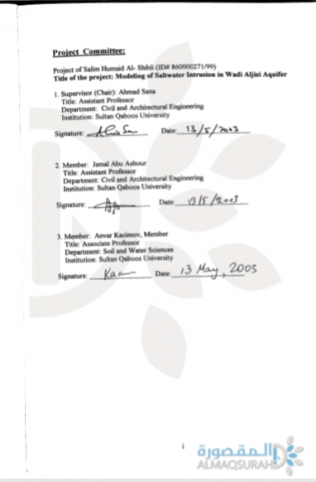
The rapid growth of seaboard cities and industries has altered the normal flow of fresh water to the sea. Withdrawal of water from coastal fresh water wells sometimes exceeds the ability of underlying aquifers to replenish the fresh water supply, allowing salt water to seep into fresh water sources. This "salt water intrusion" is contaminating the water supply to the existing populations and industries and threatening their future growth. Most of the agricultural development in Sultanate of Oman is concentrated along the coastal strip of the Batinah plain. Due to the total dependence upon groundwater by withdrawal from wells and inadequate surface water recharge, the initial equilibrium of groundwater conditions has been upset with the consequent effect of saline water up coning and intrusion. Wadi AI Jizi aquifer is one of the Batinah coastal plain aquifers that salt-water intrusion represents a significant threat to water quality. In the present study, the Groundwater Modeling System (GMS) is used that includes MODFLOW in addition to MT3DMS module (Mass Transport Three-dimensional for Multi-Species) for groundwater transport processes. First, a conceptual model for Jizi aquifer was developed based on available hydrogeological data. The next step was the calibration of the model with steady state flow simulation of the groundwater head distribution for the starting simulation year which was selected to be the year of 1988. Then the calibration was conducted for the period up to 2001. After calibration was made, the model was used to predict water level fluctuations for the next 18 years, up to year 2020. Similar procedures were followed to simulate seawater intrusion using MT3DMS in order to predict the salinity movement. The 3-D Mass Transport Module (MT3DMS) uses the outcomes of MODFLOW runs as one of its inputs, so MODFLOW has to be run first. The model could compute the groundwater heads for the Jizi aquifer with a good match with the observed values and with a very good accuracy for salinity concentration in selected observation wells. The computed fluctuations of both water level and salinity concentration were based on a sequence of wet and dry periods (3 years wet and 4 years dry) similar to the pattern that has been observed during the previous 15 years (1988-2001). The main conclusion was that the GMS modules can be used for groundwater simulation and seawater intrusion study in AI Batinah coastal plain aquifers adjacent to the Wadi AI Jizi aquifer. The model of Jizi aquifer of groundwater flow and seawater intrusion gives good indications of the future conditions depending mainly on the accuracy of assumed recharge and pumping rates. The study shows that Wadi AI Jizi aquifer can accommodate the demand with slight increase in seawater intrusion.
The rapid growth of seaboard cities and industries has altered the normal flow of fresh water to the sea. Withdrawal of water from coastal fresh water wells sometimes exceeds the ability of underlying aquifers to replenish the fresh water supply, allowing salt water to seep into fresh water sources....